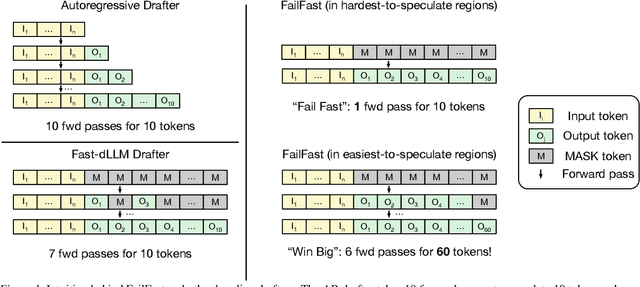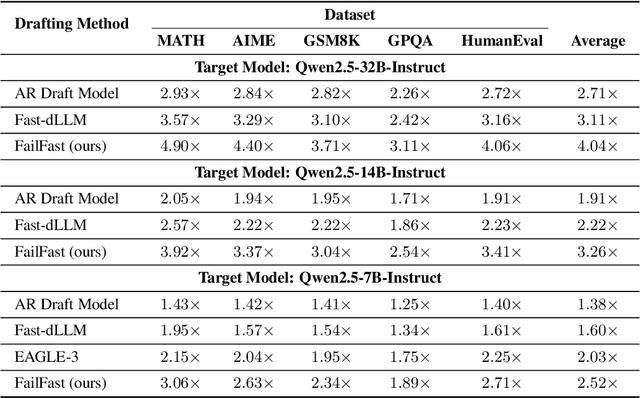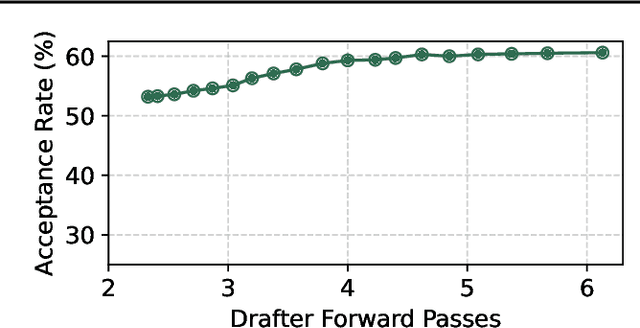Rui Pan
Fail Fast, Win Big: Rethinking the Drafting Strategy in Speculative Decoding via Diffusion LLMs
Dec 23, 2025



Abstract:Diffusion Large Language Models (dLLMs) offer fast, parallel token generation, but their standalone use is plagued by an inherent efficiency-quality tradeoff. We show that, if carefully applied, the attributes of dLLMs can actually be a strength for drafters in speculative decoding with autoregressive (AR) verifiers. Our core insight is that dLLM's speed from parallel decoding drastically lowers the risk of costly rejections, providing a practical mechanism to effectively realize the (elusive) lengthy drafts that lead to large speedups with speculative decoding. We present FailFast, a dLLM-based speculative decoding framework that realizes this approach by dynamically adapting its speculation length. It "fails fast" by spending minimal compute in hard-to-speculate regions to shrink speculation latency and "wins big" by aggressively extending draft lengths in easier regions to reduce verification latency (in many cases, speculating and accepting 70 tokens at a time!). Without any fine-tuning, FailFast delivers lossless acceleration of AR LLMs and achieves up to 4.9$\times$ speedup over vanilla decoding, 1.7$\times$ over the best naive dLLM drafter, and 1.4$\times$ over EAGLE-3 across diverse models and workloads. We open-source FailFast at https://github.com/ruipeterpan/failfast.
NegoCollab: A Common Representation Negotiation Approach for Heterogeneous Collaborative Perception
Oct 31, 2025Abstract:Collaborative perception improves task performance by expanding the perception range through information sharing among agents. . Immutable heterogeneity poses a significant challenge in collaborative perception, as participating agents may employ different and fixed perception models. This leads to domain gaps in the intermediate features shared among agents, consequently degrading collaborative performance. Aligning the features of all agents to a common representation can eliminate domain gaps with low training cost. However, in existing methods, the common representation is designated as the representation of a specific agent, making it difficult for agents with significant domain discrepancies from this specific agent to achieve proper alignment. This paper proposes NegoCollab, a heterogeneous collaboration method based on the negotiated common representation. It introduces a negotiator during training to derive the common representation from the local representations of each modality's agent, effectively reducing the inherent domain gap with the various local representations. In NegoCollab, the mutual transformation of features between the local representation space and the common representation space is achieved by a pair of sender and receiver. To better align local representations to the common representation containing multimodal information, we introduce structural alignment loss and pragmatic alignment loss in addition to the distribution alignment loss to supervise the training. This enables the knowledge in the common representation to be fully distilled into the sender.
Lean4Physics: Comprehensive Reasoning Framework for College-level Physics in Lean4
Oct 30, 2025Abstract:We present **Lean4PHYS**, a comprehensive reasoning framework for college-level physics problems in Lean4. **Lean4PHYS** includes *LeanPhysBench*, a college-level benchmark for formal physics reasoning in Lean4, which contains 200 hand-crafted and peer-reviewed statements derived from university textbooks and physics competition problems. To establish a solid foundation for formal reasoning in physics, we also introduce *PhysLib*, a community-driven repository containing fundamental unit systems and theorems essential for formal physics reasoning. Based on the benchmark and Lean4 repository we composed in **Lean4PHYS**, we report baseline results using major expert Math Lean4 provers and state-of-the-art closed-source models, with the best performance of DeepSeek-Prover-V2-7B achieving only 16% and Claude-Sonnet-4 achieving 35%. We also conduct a detailed analysis showing that our *PhysLib* can achieve an average improvement of 11.75% in model performance. This demonstrates the challenging nature of our *LeanPhysBench* and the effectiveness of *PhysLib*. To the best of our knowledge, this is the first study to provide a physics benchmark in Lean4.
ERA: Transforming VLMs into Embodied Agents via Embodied Prior Learning and Online Reinforcement Learning
Oct 14, 2025Abstract:Recent advances in embodied AI highlight the potential of vision language models (VLMs) as agents capable of perception, reasoning, and interaction in complex environments. However, top-performing systems rely on large-scale models that are costly to deploy, while smaller VLMs lack the necessary knowledge and skills to succeed. To bridge this gap, we present \textit{Embodied Reasoning Agent (ERA)}, a two-stage framework that integrates prior knowledge learning and online reinforcement learning (RL). The first stage, \textit{Embodied Prior Learning}, distills foundational knowledge from three types of data: (1) Trajectory-Augmented Priors, which enrich existing trajectory data with structured reasoning generated by stronger models; (2) Environment-Anchored Priors, which provide in-environment knowledge and grounding supervision; and (3) External Knowledge Priors, which transfer general knowledge from out-of-environment datasets. In the second stage, we develop an online RL pipeline that builds on these priors to further enhance agent performance. To overcome the inherent challenges in agent RL, including long horizons, sparse rewards, and training instability, we introduce three key designs: self-summarization for context management, dense reward shaping, and turn-level policy optimization. Extensive experiments on both high-level planning (EB-ALFRED) and low-level control (EB-Manipulation) tasks demonstrate that ERA-3B surpasses both prompting-based large models and previous training-based baselines. Specifically, it achieves overall improvements of 8.4\% on EB-ALFRED and 19.4\% on EB-Manipulation over GPT-4o, and exhibits strong generalization to unseen tasks. Overall, ERA offers a practical path toward scalable embodied intelligence, providing methodological insights for future embodied AI systems.
Generalizable Geometric Image Caption Synthesis
Sep 18, 2025Abstract:Multimodal large language models have various practical applications that demand strong reasoning abilities. Despite recent advancements, these models still struggle to solve complex geometric problems. A key challenge stems from the lack of high-quality image-text pair datasets for understanding geometric images. Furthermore, most template-based data synthesis pipelines typically fail to generalize to questions beyond their predefined templates. In this paper, we bridge this gap by introducing a complementary process of Reinforcement Learning with Verifiable Rewards (RLVR) into the data generation pipeline. By adopting RLVR to refine captions for geometric images synthesized from 50 basic geometric relations and using reward signals derived from mathematical problem-solving tasks, our pipeline successfully captures the key features of geometry problem-solving. This enables better task generalization and yields non-trivial improvements. Furthermore, even in out-of-distribution scenarios, the generated dataset enhances the general reasoning capabilities of multimodal large language models, yielding accuracy improvements of $2.8\%\text{-}4.8\%$ in statistics, arithmetic, algebraic, and numerical tasks with non-geometric input images of MathVista and MathVerse, along with $2.4\%\text{-}3.9\%$ improvements in Art, Design, Tech, and Engineering tasks in MMMU.
Theoretical Analysis on how Learning Rate Warmup Accelerates Convergence
Sep 09, 2025Abstract:Learning rate warmup is a popular and practical technique in training large-scale deep neural networks. Despite the huge success in practice, the theoretical advantages of this strategy of gradually increasing the learning rate at the beginning of the training process have not been fully understood. To resolve this gap between theory and practice, we first propose a novel family of generalized smoothness assumptions, and validate its applicability both theoretically and empirically. Under the novel smoothness assumption, we study the convergence properties of gradient descent (GD) in both deterministic and stochastic settings. It is shown that learning rate warmup consistently accelerates GD, and GD with warmup can converge at most $\Theta(T)$ times faster than with a non-increasing learning rate schedule in some specific cases, providing insights into the benefits of this strategy from an optimization theory perspective.
Beyond BEV: Optimizing Point-Level Tokens for Collaborative Perception
Aug 27, 2025Abstract:Collaborative perception allows agents to enhance their perceptual capabilities by exchanging intermediate features. Existing methods typically organize these intermediate features as 2D bird's-eye-view (BEV) representations, which discard critical fine-grained 3D structural cues essential for accurate object recognition and localization. To this end, we first introduce point-level tokens as intermediate representations for collaborative perception. However, point-cloud data are inherently unordered, massive, and position-sensitive, making it challenging to produce compact and aligned point-level token sequences that preserve detailed structural information. Therefore, we present CoPLOT, a novel Collaborative perception framework that utilizes Point-Level Optimized Tokens. It incorporates a point-native processing pipeline, including token reordering, sequence modeling, and multi-agent spatial alignment. A semantic-aware token reordering module generates adaptive 1D reorderings by leveraging scene-level and token-level semantic information. A frequency-enhanced state space model captures long-range sequence dependencies across both spatial and spectral domains, improving the differentiation between foreground tokens and background clutter. Lastly, a neighbor-to-ego alignment module applies a closed-loop process, combining global agent-level correction with local token-level refinement to mitigate localization noise. Extensive experiments on both simulated and real-world datasets show that CoPLOT outperforms state-of-the-art models, with even lower communication and computation overhead. Code will be available at https://github.com/CheeryLeeyy/CoPLOT.
Subjective Perspectives within Learned Representations Predict High-Impact Innovation
Jun 05, 2025Abstract:Existing studies of innovation emphasize the power of social structures to shape innovation capacity. Emerging machine learning approaches, however, enable us to model innovators' personal perspectives and interpersonal innovation opportunities as a function of their prior trajectories of experience. We theorize then quantify subjective perspectives and innovation opportunities based on innovator positions within the geometric space of concepts inscribed by dynamic language representations. Using data on millions of scientists, inventors, writers, entrepreneurs, and Wikipedia contributors across the creative domains of science, technology, film, entrepreneurship, and Wikipedia, here we show that measured subjective perspectives anticipate what ideas individuals and groups creatively attend to and successfully combine in future. When perspective and background diversity are decomposed as the angular difference between collaborators' perspectives on their creation and between their experiences, the former consistently anticipates creative achievement while the latter portends its opposite, across all cases and time periods examined. We analyze a natural experiment and simulate creative collaborations between AI (large language model) agents designed with various perspective and background diversity, which are consistent with our observational findings. We explore mechanisms underlying these findings and identify how successful collaborators leverage common language to weave together diverse experience obtained through trajectories of prior work that converge to provoke one another and innovate. We explore the importance of these findings for team assembly and research policy.
MiCRo: Mixture Modeling and Context-aware Routing for Personalized Preference Learning
May 30, 2025Abstract:Reward modeling is a key step in building safe foundation models when applying reinforcement learning from human feedback (RLHF) to align Large Language Models (LLMs). However, reward modeling based on the Bradley-Terry (BT) model assumes a global reward function, failing to capture the inherently diverse and heterogeneous human preferences. Hence, such oversimplification limits LLMs from supporting personalization and pluralistic alignment. Theoretically, we show that when human preferences follow a mixture distribution of diverse subgroups, a single BT model has an irreducible error. While existing solutions, such as multi-objective learning with fine-grained annotations, help address this issue, they are costly and constrained by predefined attributes, failing to fully capture the richness of human values. In this work, we introduce MiCRo, a two-stage framework that enhances personalized preference learning by leveraging large-scale binary preference datasets without requiring explicit fine-grained annotations. In the first stage, MiCRo introduces context-aware mixture modeling approach to capture diverse human preferences. In the second stage, MiCRo integrates an online routing strategy that dynamically adapts mixture weights based on specific context to resolve ambiguity, allowing for efficient and scalable preference adaptation with minimal additional supervision. Experiments on multiple preference datasets demonstrate that MiCRo effectively captures diverse human preferences and significantly improves downstream personalization.
AstroMLab 4: Benchmark-Topping Performance in Astronomy Q&A with a 70B-Parameter Domain-Specialized Reasoning Model
May 23, 2025Abstract:General-purpose large language models, despite their broad capabilities, often struggle with specialized domain knowledge, a limitation particularly pronounced in more accessible, lower-parameter versions. This gap hinders their deployment as effective agents in demanding fields such as astronomy. Building on our prior work with AstroSage-8B, this study introduces AstroSage-70B, a significantly larger and more advanced domain-specialized natural-language AI assistant. It is designed for research and education across astronomy, astrophysics, space science, astroparticle physics, cosmology, and astronomical instrumentation. Developed from the Llama-3.1-70B foundation, AstroSage-70B underwent extensive continued pre-training on a vast corpus of astronomical literature, followed by supervised fine-tuning and model merging. Beyond its 70-billion parameter scale, this model incorporates refined datasets, judiciously chosen learning hyperparameters, and improved training procedures, achieving state-of-the-art performance on complex astronomical tasks. Notably, we integrated reasoning chains into the SFT dataset, enabling AstroSage-70B to either answer the user query immediately, or first emit a human-readable thought process. Evaluated on the AstroMLab-1 benchmark -- comprising 4,425 questions from literature withheld during training -- AstroSage-70B achieves state-of-the-art performance. It surpasses all other tested open-weight and proprietary models, including leading systems like o3, Gemini-2.5-Pro, Claude-3.7-Sonnet, Deepseek-R1, and Qwen-3-235B, even those with API costs two orders of magnitude higher. This work demonstrates that domain specialization, when applied to large-scale models, can enable them to outperform generalist counterparts in specialized knowledge areas like astronomy, thereby advancing the frontier of AI capabilities in the field.
 Add to Chrome
Add to Chrome Add to Firefox
Add to Firefox Add to Edge
Add to Edge